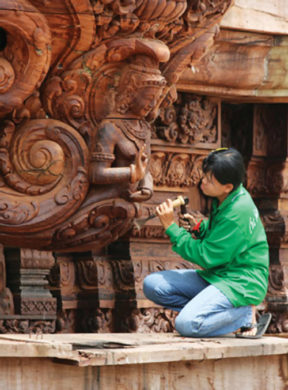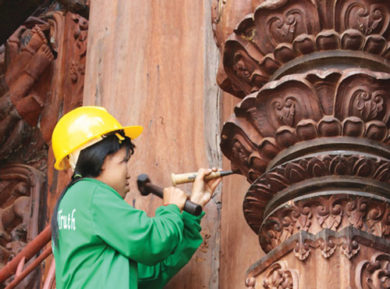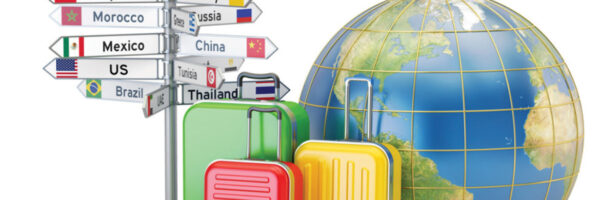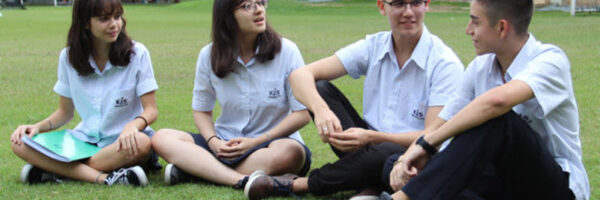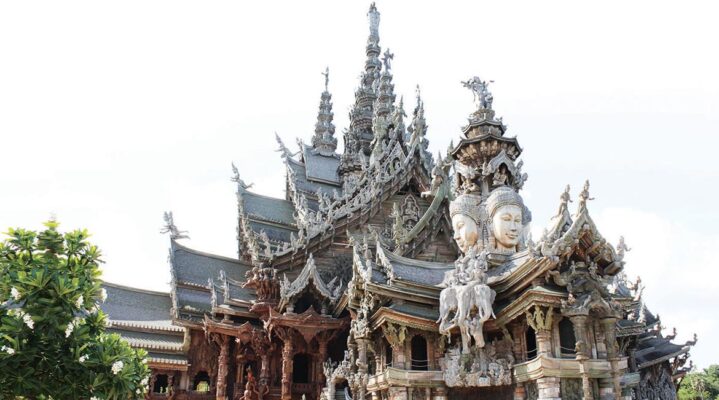
Magnificence of the Sanctuary of Truth
The scene is astonishing! With an area of thirty two acres, intricately carved teakwood and a gigantic height of one hundred five metres stand majestically – an architectural wonder seen by only a few in Thailand.
The magnificence of Sanctuary of Truth is in its building of intricate carved wood that must have taken millions of hours of the best craftsmen in Thailand. Every piece of wood some imported from Malaysia, Myanmar and Laos has a story to tell and centuries old original. One panel flooring which is two inches thick is cut from one huge tree and each tree can only produce two panels of straight almost perfect hardwood. Looking around you feel the spirit of a bygone era still echoes within its interior where huge pillars stand proud.
As you enter the elevated complex, you gasp at the even more incredible vision ahead. The high ceiling measuring about sixty metres shows beautifully handcrafted carvings probably never seen before. You are still rubbing your eyes of wonderment and disbelief when you stop to stare at the finely carved figures on its posts with obvious manpower time and effort spent. The carvings are not just Asian design but also depict Persian art. The rest of the structure is covered with giant carvings depicting ancient Buddhist, Hindu and Chinese arts.
This building that awes people who have seen it called ‘Sanctuary of Truth” is another work initiated by the late Khun Lek Viriviphan, the same man behind mega projects such as Muang Boran (Ancient City) and Erawan Shrine, amongst others. His spirit and passion laid out the masterplan of this unique place after completion of Muang Boran. Khun Lek was a very simple man who rose from humble beginnings. He had excellent understanding of various religions and practices in his lifetime the value of respect, trust, love and generosity that he thought of this colossal project for his people to learn by. It’s a whole new world of knowledge of Asian art and history made available to everyone for a measly entrance fee. Khun Lek also chose the city of Pattaya known for its bold entertainment to build this structure to change the people’s view of the city as not just the amusement capital of Thailand but as a cultural hub, a place for art and culture.
Khun Lek gave the best part of his life building projects leading hundreds of the best builders and craftsmen.
The quality of design emphasises Thailand’s shared artistic tradition with its neighbours, China, Laos, India and Cambodia through assimilation of its neighbours’ architectural technique. The building which was started in 1981 is 85% complete and expected to finish in another 15 years. There are various misconceptions about the structure. Some thought that every wing represents one country’s culture and art but the truth when you look at each carvings you can vividly see the various cultures that is depicted in every layer of art.
The west wing which is called the beginning of time shows the four elements in its sculpture. The wind element shows the movement of the wind passing the trees in the way the trees are carved.
The second element which is fire shows a sculpture of a Chinese dragon. The water element which covers the world is manifested by a simulation of water flowing signifying the beginning of life and the earth element shows a sculpture of half man/half woman which signifies fertility.
Another misconception is that due to it’s proximity to ocean the colour of the wood changes to copper like and some parts had to be refurbish due to termites that can be frustrating to the artisans in charge of restoring a new structure. The truth is the greenish colour is due to the solution with copper contents injected to the wood to help in its preservation.
Looking at the intricately carved statues, you are almost taken into a vision of ambiguity and awe. Our very knowledgeable guide, explains what the figures represent and symbolises but with hundreds of them I can only absorb so much. It is explained further that the four-faced Brahma is an artist’s interpretation of God who sees everything around him and not the common belief that he has four faces. There is also a sculpture of Lord Krishna holding a woman which symbolises man’s duty of protecting a woman and not as an object of lust although Lord Krishna was construed as a lover of women. Another sculpture is that of Krishna again lifting the mountain which represents the world and the life under him as his people he is protecting from harm and devastation of flood, reminiscent of Noah’s Ark but in a different perspective. The East wing shows a huge sculpture of a family which is the most important aspect in a person’s life. It represents the parents’ responsibility of nurturing their children with love, respect, trust and knowledge. As a result of these good values instilled into the children, they will also in return share the same values to their neighbours, their surroundings, only when the world follows this philosophy that peace will come forth.
In the Northern part of the structure are visibly Chinese sculptures but as you come closer, it’s not just pure Chinese but a combination of Chinese, Thai and Burmese art put together as one. What were noticeable are the eight sided posts which are completely different in design as the posts in the southern wing.
For centuries, the Chinese believe that eight is the most auspicious number so the eight sided posts follow a superstitious belief that eight is a symbol of wealth and power. With the Northern part of the wing as the beginning of the Thai civilisation and closer to China, the architecture here depicts its relationship with the country and how the belief was passed on to its neighbour.
When you make a 180 degree turn to the South it shows differently designed posts that of the Khmer era. Obviously influenced by Hindu art, it shows Lord Krishna in different forms. The wing also shows different sculptures representing the deities who control the movements of the nine planets.
In Khun Lek’s vision, he unselfishly included other cultures by combining arts represented by these countries on its four wings. As the sun sets and the rays touch a ball of sand that hits the building, part of it illuminates that gives a magical moment. It takes you to the understanding of what the edifice in the middle represents. It’s one huge structure with four open sides and with five steps taking you inside. The openness is a symbol that everyone can enter enlightenment. It’s never too late to fight evil and be united to reach Nirvana. Happiness is a state of being desired by every man, whatever his religion, race or creed but it’s only by truth, respect, kindness, love and trust that man can achieve it. Furthermore, Khun Lek believes that humans are merely dust in this world and that we shall return to it when our time comes to an end.
The Sanctuary of Truth is not just a beautiful teak wood monument. It is not considered a temple, a palace or a home. It is open to everyone as is evident by the no doors and open air atmosphere. It is a museum of fine arts taken from various cultures put together as one to create a beautiful masterpiece. In the same concept that man too who comes from diverse culture can come together and be united as one for peace. If it’s possible to put man in the same light as how the building was formed, peace will reign in the world.
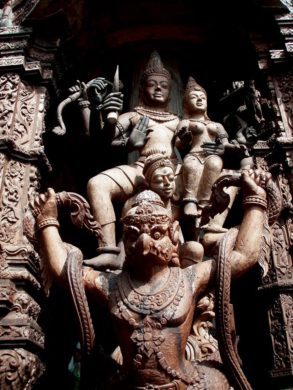
Blown away ten times more, the concept is based on philosophy. No corners were made without a meaning. They are all connected like the universe. Every piece of wood, every design to the smallest detail was not created just for beauty but with a purpose.
It is a one man’s vision … a genius.


